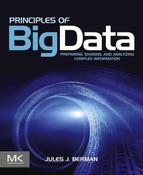Table of Contents
The Most Common Purpose of Big Data is to Produce Small Data
Big Data Moves to the Center of the Information Universe
Chapter 1. Providing Structure to Unstructured Data
Chapter 2. Identification, Deidentification, and Reidentification
Features of an Identifier System
Registered Unique Object Identifiers
Embedding Information in an Identifier: Not Recommended
Use Case: Hospital Registration
Chapter 3. Ontologies and Semantics
Classifications, the Simplest of Ontologies
Ontologies, Classes with Multiple Parents
Introduction to Resource Description Framework Schema
Common Pitfalls in Ontology Development
Namespaces and the Aggregation of Meaningful Assertions
Resource Description Framework Triples
Chapter 5. Data Integration and Software Interoperability
The Committee to Survey Standards
Interfaces to Big Data Resources
Chapter 6. Immutability and Immortality
Reconciling Identifiers across Institutions
Practical Significance of Measurements
Obsessive-Compulsive Disorder: The Mark of a Great Data Manager
Chapter 8. Simple but Powerful Big Data Techniques
Use Case: Watching Data Trends with Google Ngrams
Use Case: Estimating Movie Preferences
Clustering, Classifying, Recommending, and Modeling
Normalizing and Adjusting Data
Big Data Software: Speed and Scalability
Find Relationships, Not Similarities
Chapter 10. Special Considerations in Big Data Analysis
Data Subsets in Big Data: Neither Additive nor Transitive
Chapter 11. Stepwise Approach to Big Data Analysis
Step 1. A Question Is Formulated
Step 3. A Question Is Reformulated
Step 7. Algorithms Are Selected, If Absolutely Necessary
Step 8. Results Are Reviewed and Conclusions Are Asserted
Step 9. Conclusions Are Examined and Subjected to Validation
Save Money; Don’t Protect Harmless Information
Use Case: Cancer Biomedical Informatics Grid, a Bridge too Far
Responsibility for the Accuracy and Legitimacy of Contained Data
Rights to Create, Use, and Share the Resource
Copyright and Patent Infringements Incurred by Using Standards
Good Policies Are a Good Policy
The Necessity of Data Sharing, Even When It Seems Irrelevant
